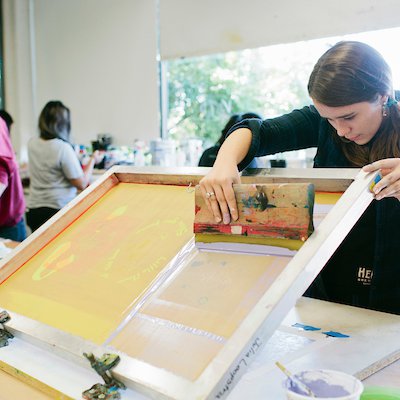The Important Overview to Comprehending Screen Printing and Its Versatile Uses
Screen printing has an abundant history that dates back to old times, evolving right into an innovative method made use of throughout numerous industries today. This overview explores the intricacies of the screen printing process, describing its applications in fashion, home, and advertising and marketing design - 10:9 Design Abilene. Recognizing these fundamentals can open up imaginative potential for both creative and business tasks. The following areas will expose essential suggestions and methods to boost one's screen printing undertakings
The Background of Screen Printing
Although screen printing has roots that trace back centuries, its evolution shows the artistic and technological improvements of different societies. Stemming in ancient China, the strategy was initially used for decorating textiles and later spread to Japan, where it became essential to Ukiyo-e woodblock printing. The technique moved to Europe in the 18th century, where it acquired popularity among craftsmens and business printers. The development of image solution in the 20th century reinvented screen printing, enabling more elaborate styles and greater efficiency. Musicians like Andy Warhol additionally thrust its appeal, utilizing the medium to create legendary jobs that blended commercialism and art. By the late 20th century, screen printing had actually developed itself as a flexible technique, used in vogue, marketing, and art. Today, it remains to progress, integrating electronic innovation and expanding its applications throughout different industries.
The Screen Printing Refine Explained
Screen printing transforms imaginative visions into substantial layouts with a collection of exact steps. At first, an image is developed and then moved onto a screen, normally made of great mesh fabric stretched over a framework. A light-sensitive solution is put on the screen, which is subjected to light, setting in areas not covered by the picture. After washing out the unhardened emulsion, a stencil is created.
Next, the screen is put over the substrate, whether it be material, paper, or one more product. Ink is then pushed via the open locations of the stencil using a squeegee, depositing the style onto the substratum listed below. This process can be repeated for numerous colors, needing different displays for each shade. The published item is treated utilizing warm to ensure the ink sticks properly, resulting in a long lasting, vivid layout all set for usage.
Kinds of Screen Printing Techniques

In addition, specialized strategies, such as discharge screen printing, get rid of color from the fabric to produce softer prints, while foil screen printing applies metallic foil to achieve a shiny surface (10:9 Design Embroidery). Each strategy supplies distinctive features, accommodating various creative needs and manufacturing ranges, inevitably increasing the possibilities within the screen printing domain
Applications of Screen Printing in Different Industries

Additionally, the signs and advertising industries utilize screen printing for producing appealing display screens and banners. This technique permits strong colors and intricate styles that more information record interest. In electronic devices, screen printing is employed for applying conductive inks to motherboard, crucial for element links. The home style industry accepts screen printing to create distinctive layouts on fabrics and wall art. In general, screen printing functions as a critical tool throughout diverse fields, improving items with individualized and aesthetically appealing graphics.
Tips for Successful Screen Printing Projects
While embarking on a screen printing project, careful interest to detail can significantly improve the last result. Choosing top notch products is necessary; click here to read this consists of the screen, inks, and substratums. Utilizing proper mesh counts can affect ink deposition and detail resolution. Prep work is just as vital; thorough cleansing of screens and proper direct exposure times assure crisp prints.
Next off, precise registration is crucial for multi-color prints. Making use of alignment devices can aid achieve specific layering. Additionally, testing prints on scrap products before manufacturing aids recognize prospective issues without wasting sources.

Regularly Asked Concerns
What Materials Are Best for Screen Printing on Textile?
Cotton and polyester blends are suitable for screen printing on material due to their durability and ink absorption. In addition, specialized fabrics like silk or canvas can generate one-of-a-kind structures and finishes, boosting the general design top quality.
Exactly how Do I Tidy and Maintain Screen Printing Devices?
To clean up and keep screen printing tools, one ought to regularly wash displays with suitable solvents, inspect mops for wear, lubricate relocating parts, and shop all items in a completely dry, dust-free environment to lengthen their lifespan.
What Are the Environmental Impacts of Screen Printing?
Screen printing can have considerable ecological effects, consisting of chemical waste from inks and solvents, water use throughout cleaning procedures, and power consumption. Lasting practices and green materials are essential for lessening these adverse effects.
Can Screen Printing Be Done in your home Properly?
Screen printing can be effectively done at home with the ideal products and strategies. visit our website Hobbyists can create high quality prints, though success depends upon their ability level, tools, and understanding of the procedure entailed.
What Are the Costs Related To Starting a Screen Printing Company?

Starting a screen printing company includes costs for equipment, products, and work space. Preliminary costs normally range from a few hundred to several thousand bucks, depending upon the scale, quality of equipment, and preferred production ability.
Screen printing has an abundant history that dates back to old times, advancing into an innovative strategy utilized across numerous markets today. Another strategy, rotary screen printing, employs cylindrical screens, promoting constant printing on fabric rolls, therefore improving efficiency for massive manufacturings. Furthermore, specialized techniques, such as discharge screen printing, remove color from the material to create softer prints, while foil screen printing applies metal aluminum foil to accomplish a glossy coating. In the fashion sector, screen printing is commonly used to produce vibrant styles on garments, enabling brand names to showcase their special styles. Cotton and polyester blends are suitable for screen printing on textile due to their toughness and ink absorption.